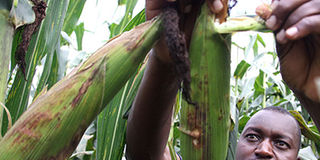The widening prosperity gap in East Africa is a good reason for pessimism

A farmer in Uasin Gishu County inspects his maize farm. PHOTO | JARED NYATAYA | NATION
What you need to know:
- Across the region, the richest are the overwhelming beneficiaries of economic growth, while the poorest are falling further behind.
- In many ways, the foundations for building more inclusive societies — societies that are ultimately richer and politically stable — must be laid in the countryside.
In recent years, the narrative of a “rising Africa” has been embraced by some and debunked by others.
But all agree on what social engineers call “inclusiveness” — the degree to which members of a society share in its prosperity. With it, say the boosters, Africa will rise. Without it, say the sceptics, it cannot.
Africa’s future really is as simple as that. Without a sense of social contract — a faith in shared progress — economies tend to become unstable and fall apart.
“No society that hopes to prosper,” writes the economist Jeffrey Sachs in his book, The Price of Civilisation, “can afford to leave large parts of its population stuck in the poverty trap.”
Against this background, a new report by the Society for International Development (SID) in Nairobi is a sobering read. Its conclusion: a rising Africa — and in particular a rising East Africa — will never become a reality without economic progress across all sectors of society.
Superficially, East Africa appears to be doing well. Annual economic growth rates are averaging around 6 per cent, and trade and foreign investment are rising. Some countries, such as Uganda and Tanzania, have large energy-resource endowments.
EROSION OF PUBLIC CONFIDENCE
In Kenya, the region’s largest economy, finance and new consumer service industries are propelling growth — an important economic evolution.
Look deeper, however, and it is difficult not to worry. Across the region, the richest are the overwhelming beneficiaries of economic growth, while the poorest are falling further behind.
Numbers tell part of the story. The richest 10 per cent of East Africans tend to live in cities, work in industry or professional services, and send their children to private schools. Their East Africa, according to the report, resembles Central America or a lower-middle-income European country.
By contrast, the bottom 40 per cent of East Africans make do on $225 a year — significantly below the threshold of $1.25 a day that development experts use to define extreme poverty.
These poorest of the poor are mostly rural. They live without basic utilities such as power, clean water, and sanitation. Their children have a 40-80 per cent higher chance of dying before their fifth birthday.
Some problems cut across the extreme-poverty divide. Childhood stunting is on the rise everywhere, affecting 42 per cent of the region’s 24 million under-five children.
All East African countries have achieved high primary school enrolment, but only 28 per cent of pupils in Uganda, and 49 per cent in Kenya go on to secondary school.
In Rwanda and Uganda, 88 per cent of secondary students pass exams; in Tanzania and Kenya, the proportion is less than 30 per cent.
Unsurprisingly, the 2012 Afrobarometer survey indicates a sharp erosion of public confidence. In Tanzania, 40 per cent of those polled described current economic conditions as “very bad.”
Two thirds of Ugandans felt similarly, up sharply from 42 per cent in 2010. In Kenya, 84 per cent of adults described the economy as either “very bad” or “fairly bad” — a 30-point jump from 2005.
AGRICULTURE STAGNATING
What are governments to do in the face of such realities? For starters, East Africa’s political leaders must put aside their penchant for what the report calls “social bribery” — delivering the promise of progress without the results.
Consider agriculture, which accounts for most of the region’s real economy and employs the vast majority of East Africans. Yet the sector is stagnating, with growth rates that are less than half of those attained in the rest of the economy.
And, while the average age of an East African today is less than 30 years, the mean age of a farmer is 60 years. That is no prescription for a bright future.
In many ways, the foundations for building more inclusive societies — societies that are ultimately richer and politically stable — must be laid in the countryside.
Policies that extend social services and create new economic and entrepreneurial incentives for rural communities are key. So is infrastructure development, both in the provinces and in terms of linking the region more generally.
Mr Meyer is Dean of the Graduate School of Media and Communications at Aga Khan University in Nairobi. (c): Project Syndicate, 2014.www.project-syndicate.org.




